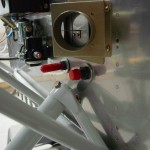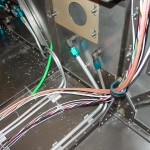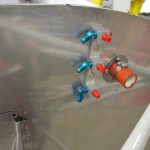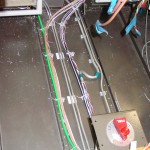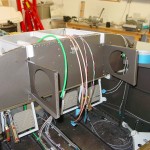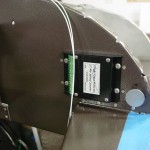12th
February
2011
Not alot of visible progress for the hours today, just working on a number of small things.
- Assembled a .040″ restrictor orifice into a -4 straight nipple fitting, and installed into the #3 cylinder for pickup of manifold pressure. The #10 sized orifice from McMaster-Carr (2943T887) works nicely in a -4 fitting size, just requiring the fitting to be tapped. After tapping the fitting, I installed the orifice with high-temp threadlocker. I also tapped the orifice from the hose side, rather than the cylinder side, so that if it were to somehow work loose, it could not travel into the engine, but into the hose.
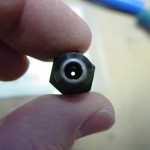

- Finished installing the wing wiring connectors by terminating the wires on the left wing.
- Reinstalled the fuel vent line tubing that passes through the fuselage sides; torqued the fittings. Cut the vent lines to proper length.
- Smoothed and flared the ends of the fuel pickup and vent tubes that protrude from the fuselage.
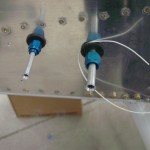
- Riveted the doubler plate for the fuel pump to the tunnel cover. Fabricated a pair of stiffener angles for the same cover, to beef up the sides of the assembly and reduce vibration. Affixed the pump to the cover plate, and test fit it in the fuselage; tweaked a couple fuel line bends to get the selector-pump-firewall plumbing aligned. Cut and terminated the fuel pump wires.
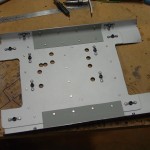
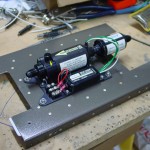
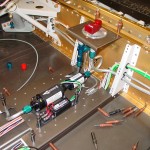
- Put some temporary zipties on the tubing in the tunnel to hold things in place for now.
- Removed the firewall passthru fittings to fabricate and install a doubler on the inside of the firewall. I had used the thick aluminim spacer/washers that Van’s sends, but there was too much flex in the FW still for my taste; this beefed it up nicely. Reinstalled fittings with doubler aft and spacers forward, and torqued fuel & purge return lines at the firewall.
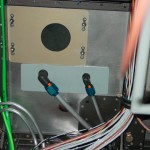
- Installed the closure pieces for the inboard seat pan ribs, that bridge the gap which is cut to allow installation/removal of the control column.
- Temporarily installed the roll trim assembly in order to find the correct angle for the metal tabs that bolt to the lower end of the control sticks, so I could torque the bolts on the rod ends that tie the sticks together in roll. Also to see how the trim goes together. Followed the plans for setting the spring lengths, but they seem as though they might be overly tensioned…need to see where others have ended up on the length. The issue may be that the plans have you use the forward-left-most stick position to set the spring lengths, and without the elevators and ailerons attached to hit their stops, I suspect the stick travel is a fair bit more than it would be normally, which would result in stretching the springs excessively. So, setting the spring length may end up part of the after-final-wing-mating task list.
- Also torqued the bolt for the elevator pushrod at the control column.
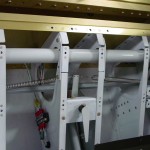
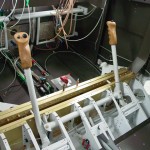
I found that the Goop used on the stick grips cured well, and the grips are solid. Also sent off what I hope will be the last of the minor revisions on the panel layout, so that should be cut sometime next week and on its way. Hoping to have the harnesses from SteinAir sometime soon, as that’s all I’m waiting on to wrap up the airframe wiring. Had made contact with the engravers about doing the placards for the panel, but they seem to be slow on the email (or at least haven’t replied yet), so I’m not sure the current status of that piece.
Hours: 6.8 | Posted in Center Fuselage, Electrical, Plumbing |
6th
February
2011
More work on wiring, essentially finishing up the stick install from yesterday by tying up wires and connecting connectors, making sure everything is neat and secure. Also installed connectors on the feed to the flap motor and hooked it up, as well as the heated seat power lines, and the flap position sensor. I’m not going to final-mount the position sensor yet, as I need to obtain some threaded rod and clevises to hook it up.
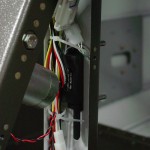
Vacuumed out the area under the seat pans, then decided to cut out the left panel support rib (which will be reinstalled a few inches to the right, to clear the EFIS screens). That, of course, required another vacuuming…but the Dremel with a cutoff wheel made easy work of it, then cleaned up the cut edge with files. Dust was mostly controlled by holding the vacuum nozzle alongside the cutting wheel.
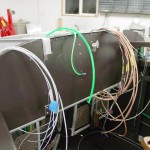
With those items finished, I moved on to the largest of the airframe connectors: the wing roots, which are 22-pin CPC’s. (Not all 22 pins are used, though.) The biggest thing for working with these connectors is to make a good chart of what’s hooked up to which pin, so that both sides of the connector end up the same. I also used the same pins on left and right sides for functions that are duplicated on both sides (landing/taxi lights and nav/strobes). I was able t0 finish both fuselage sides and the right wing before dinner.
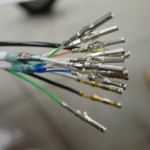
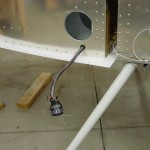
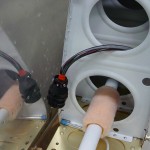
Hours: 4.5 | Posted in Electrical |
5th
February
2011
Working on several areas today:
- Installed 1/8″ NPT to barb fitting nipples in the transducer manifold for the manifold pressure line; one will feed MP to the P-Mags, the other to the sensor for the engine monitor screen.
- Fit and temporary-installed silicone tubing from the manifold to the P-mags, and a stub for the MP sensor when it arrives.
- Measured for fuel hoses and pressure sensor lines (fuel, oil, MP) with a piece of tubing. I should now have the list of most of what I need to order, except for the oil cooler hoses, which I won’t be able to measure until baffles and cooler are installed.
- Ran wire from the panel to the wing roots, forward of the main spar, for the fuel level sensors; wires I forgot in the earlier wiring work to those locations.
- Pulled wires to the FWF electrical area, for master contactor, starter engage, and starter engaged annunciator. Terminated and landed the contactor ends, and verified proper operation of the contactors. Secured the wires, at least for now. These should eventually get high-temp tie-wraps.
- Wired the connectors on the stick grips, and glued the grips on with Goop. I’ll have to see how it cures in a few days, whether it’s too soft for this or not. I believe it will be removable with enough force, which would be a positive thing if I ever wanted to change grip function (add a switch, for example) or if a wire needed to be repaired. But, I want it to feel solid, and the grip not to move or flex under normal use.
- Put connectors on the master keyswitch and the aux PTT switches. These connectors aren’t strictly necessary, as the wires could be soldered to them inside the plane, but soldering is a much more pleasant experience when not carried out upside down; I also want to be able to remove the panel without the need to unsolder things, which means a connector on the master switch, since it installs from the front of the panel (unlike the toggles, which install from the back with nuts on the front side.) Installed the aux PTT switches, and glued a tie-wrap base to the underside of the forward canopy decks to secure the PTT wires and static line.
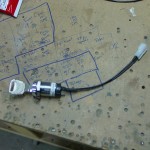
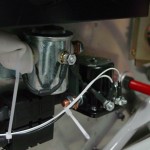
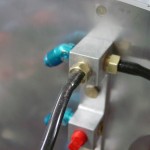
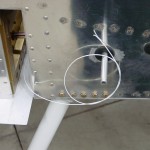
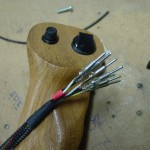
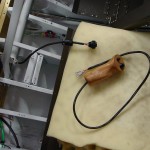
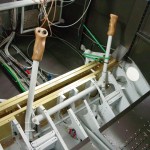
Hours: 7.3 | Posted in Cabin & Interior, Electrical, Plumbing |
30th
January
2011
I’m trying to close out wiring and stuff aft of the center section, so that the wiring runs in the tunnel can be cleaned up and tied down, then work forward with the wiring. To that end, I finished running all the wires I could aft of the center section, which today was the ELT remote (4-22 shielded) and the GPS signal run (3-22 shielded) which will feed both the ELT and the APRS tracker that I’ll mount in the same area. That finishes the aft wiring, except for five wires: 4 audio cables (pilot & pax headset & mic runs), and the cable(s) to the magnetometer(s) — I’ll run wires for 2, since each screen with airdata needs it’s own magnetometer — all of which will be included in the harness kits from SteinAir, so I’m waiting to run those.
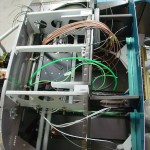
With most of the wiring aft of the firewall in place for the time being (until the harnesses are ready in a few weeks), I moved on to other aft-of-the-spar tasks — namely, the control system. I removed, primed, and reinstalled the pushrod that connects the two sticks in the roll axis, and built the forward elevator pushrod, as well as bent and installed the tabs that bolt onto the control column to connect the roll trim springs. I used a piece of light safety wire to thread the washers and rod ends into the sticks properly, but still need to torque those bolts.
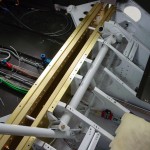
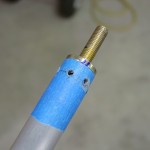
I finally got around to some housekeeping — vacuumed out the forward part of the cabin of metal shavings and debris. I need to reclaim my shop vac from the office and vacuum out under the seat pans, as I’m sure there is schmutz down there as well. Also, taped over the intake to the fuel servo to prevent the shop spiders from taking up residence in the induction system.
Another task for the evening was to cut the sticks down. I measured both sides and decided to cut off enough to compensate for the length added by the stick grips (~ 2.5″), plus another half inch. Some builders cut them way down, but I’m taking a wait-and-see approach to that, as it’s easy to cut them down farther later, but far more difficult to add some back on. After I cut them down, I (of course) had to load in the left seat and panel blank, and test it out. The length seemed pretty comf0rtable to me, and it does not appear that they will hit the panel (using a ruler to simulate the ~1.5″ I’ m adding to the bottom of the stock panel.
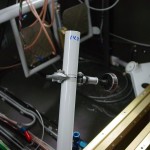
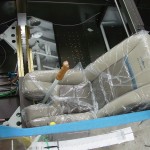
I’m working with a gent who posted on VAF about doing some panel cutting for the cost of materials and shipping, and I think we have the measurements worked out; I’ll be drop-shipping an oversize blank to him this week for cutting, so that’s coming together as well.
Hours: 5.5 | Posted in Center Fuselage, Electrical |
29th
January
2011
First item on today’s list was the intake studs on the engine sump. The ones that were on the engine as shipped were too short for the fuel servo and spacer/mount bracket, so Aero Sport Power sent out a set of longer ones. The shorter ones were removed last week, and I picked up some high-temperature threadlocker (Permatex 27200) to put on the new ones, as recommended in the Airflow Performance install manual. A few drops on the far end of the stud, a pair of nuts, and they were on and looking good. Test-mounted the bracket and servo to make sure the length was good (it was), and to look at routings for control cables and fuel lines. I’ll hold off on all that until I have an exhaust system, so as to not create any interference. Also need to work out the location of the fuel flow transducer, which will go in the feed line between the servo and the spider which sits atop the engine.
Trying to get the airframe wiring (wiring that runs to various parts of the plane — as opposed to the panel wiring, which would connect the boxes on the panel and generally contained within the “avionics bay”, or engine wiring, which would run to the forward side of the firewall) generally wrapped up. I have just about run out of space in the bushings that run through the center section, and still more wires to run, so it was time to add another bushing. Evaluating various cable paths, I decided to put it under the fuel valve, to the right side, 2/3 of the way up the spar web, which would allow the wiring to run without chafing on fuel lines or interfering with the control column, and kept a good distance away from the other bushing holes. A pilot hole a long #30, then a unibit made quick work of the holes, and I was able to use a 1/4″ drive handle to turn the unibit inside the center section to deburr the backside well. Primer, then snap bushings. (Tip: the snap bushings have a “ridge” on the inside diameter of the flange side that can be removed with a unibit, giving you an extra 1/16″ diameter…I’ve done this to all the bushings in the center section, to gain as much space as I could.)
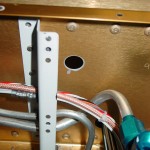

More wires to run…2 coax lines for GPS antennas behind the rear window, plus power and ground for the ELT and APRS. Need to look and see what the specified wire is for the magnetometer runs, as well as the GPS feed to the ELT/APRS (which will share a single feed line). Also finished up the last of the wing wiring with the OAT, pitot heat, and landing/taxi light wires. I tied up the bundles that run from the tunnel out to the wing roots, and sleeved the wires that pass out of the fuselage. These will get CPC connectors on both sides, and the sleeving will be maintained all the way into the connector backshell. I also put the straight union connectors on the AOA lines — the tails from the wing will pass into the fuselage, where they’ll be joined under the seat pan. May do the same with the pitot line, but for now it’s run out the side.
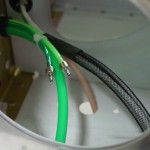
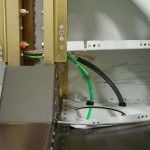
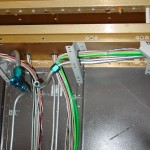
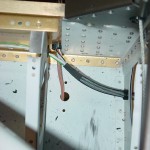
Terminated the nav/strobe wires at the terminal block under the seat; this looks like it ought to work out alright, though were I to do it over, I would have put the snap bushing for the aft wires farther away from the terminal block.
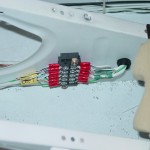
Hours: 7.5 | Posted in Electrical, Engine, Plumbing |
24th
January
2011
Not much to look at, so not many photos today. Ran more wires and tubes, including the wires for the stick functions, and mounted a terminal block for the nav/strobe lights. The power will feed to this block, then run to the wingtips and tail…this makes it so that only 1 cable needs to pass through the spar, rather than 3.
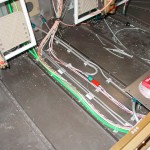
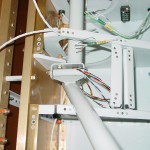
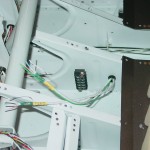
Hours: 4.2 | Posted in Electrical, Plumbing |
23rd
January
2011
Hours: 6.1 | Posted in Electrical, Plumbing |
22nd
January
2011
Fit the parking brake cable (t-handle; each cable function will have a different visual and tactile design) and test-fit the brake valve end. Need to get an adel clamp to fix the cable end in place. Installed both heater boxes, one on the right edge of the firewall, and one in the usual center position. Installed the cable eyeball for the right box.
Fabricated and installed mounting brackets for the VP-X control unit. Installed battery and ran heavy-gauge wire on the FWF side, and the main buss feed to the VP-X. Finalized install of the contactors and main fuses (alt feed & main buss), preliminary install of the alternator wire (need more adel clamps). Worked on layout of wiring runs and installation of adel clamps in the “avionics bay”, with an eye toward being able to service them from underneath the panel once the top skin is in place.
Also located and installed a bunch of tie-wrap bases in the forward tunnel with Goop (rather than the adhesive pads) to support two wire bundles, brake lines, and fuel lines.
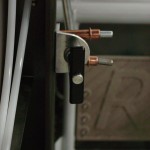
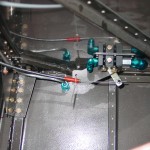
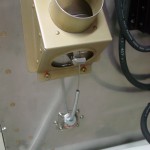
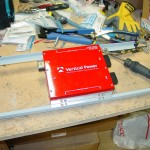
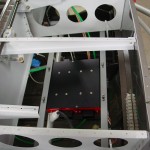
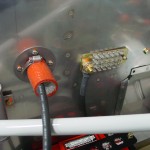
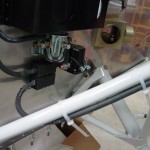
Hours: 9.4 | Posted in Electrical |
16th
January
2011
More electrical work today, though it doesn’t seem like much was accomplished for the time I spent. After finishing the installation of the terminal block for the heated seats and hooking it up, I decided to remove it and use knife splices instead. The terminal block was nearly as wide as the channel it was mounted in, and the bundle of wires running the rest of the way up the channel would have needed to pass over it. I didn’t like the looks of it, as it seemed like an opportunity for wires to chafe and short to the relatively large power line feeding the seats. I may redo it yet again with a Molex connector of some sort later…the Molexes I have now are only rated to 6 amps. I think heatshrink over the knife splices will be sufficient, however, and removed easily enough if necessary.
Next, I struggled with fitting the wiring harness for the heated seats into the allotted space. I dug out the nut-sert kit and put nuts on the left & right side of the tunnel to secure the relays; since these nuts have no self-locking feature, I used blue Loctite on the #8 screws. Also installed a wiretie base to secure the large harness/connector that leads to the relay. After monkeying with the switch harness for some time, I decided to remove the factory heatshrink, which made things far easier to deal with. I think that since it’s sold for installation into cars, they cover all the wires with the heatshrink so they’ll be protected when people don’t secure them properly. The rest of the wire bundles aren’t covered with heatshrink, though, and everything will be secured well. Without the covering, the bundles are much more flexible and I was able to spool up the excess and secure it. This could be shortened with appropriate connectors, as well, but I have nothing that’s rated for the current at the moment. I also radiused the bottom corners of the aft flap channel to provide an opening for the leads to exit en route to the cushions.
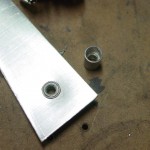
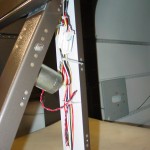
Next up was installing the map light panel — which meant running a pair of wires to it — which meant installing wire bases along the path. As long as I was stuffed into the baggage compartment with the appropriate tools, I also laid out and put wire bases on paths to the AHRS mounting area and over to the ELT mount. With all the bases in place, I pulled in the wires to the map light and put a Molex on the end, then connected and installed the map light panel. Stuck the wire ends under the battery bolts and flipped the switches, and they lit up.
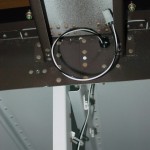
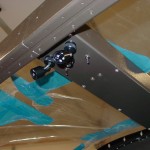
Also spent an hour or so this afternoon adjusting the panel CAD, after I realized that I had the radio stack too far to the right. The position doesn’t matter for anything that doesn’t penetrate the subpanel (since we can cut off the ribs aft of the subpanel and install them wherever they work), but since the radios need to go through the subpanel due to length, they cannot be positioned over the left or right ribs, as that’d interfere with the rib forward of the subpanel. 5/8″ to the left, problem solved.
Hours: 5.8 | Posted in Electrical |
15th
January
2011
After spending much of the day getting the CAD panel design wrapped up, I worked on a bunch of little things, mostly electrical, tonight. I was stymied in a couple places by many of my tools and supplies being at the office, so some jumping around was unavoidable.
- Assembled and installed protection diode on the starter contactor, then torqued nd marked the contactor mounting bolts…this means the contactor install is complete.
- Placed the battery in the battery box.
- Drilled holes for the auxiliary PTT switches (both left and right; right is essential for when the copilot stick is out, and the left will be handy to transmit without disturbing the stick when on autopilot).
- Installed a Molex connector on the map light panel leads to allow for easy future removal for service.
- Installed a Molex connector on the flap motor leads; same idea, especially knowing that this in even more likely to need to be serviced in the future than the LED map lights.
- Played around with some ideas for mounting the Vertical Power control unit; I could use the upper firewall angle as one mount point for a pretty clean install, but the mounting screws would be nearly impossible to get to after the top skin was on. I think I will run a pair of angles left-right across the bottom of the forward ribs, and mount the box to those. That’ll also provide for a good way to run wires left-right across the cockpit, and to strain-relief the harnesses to the control unit. The main buss wire looks like it will have a manageable path, as well.
- Drilled and installed the heated seat switches in the crosspiece aft of the seats. This position will require loosening a harness to reach in flight, but it solves the problem of needing to pass a bunch of wires through the spar. I saw this in a local builder’s plane recently, and he mentioned that downside, but said he would probably do it the same way again. I’ll only need two wires through the spar this way (both seats are sharing a power pin on the VP-X).
- Located and installed a terminal block on the vertical member under the crosspiece for the heated seat power. Removed the plastic connector from the end of the harnesses and installed ring terminals for connection to the terminal block.
- Looked at where to mount the heated seat relays; I plan to put them in the tunnel under the baggage compartment, mounted to the outboard sides. I temporarily installed the elevator pushrod to ensure there won’t be any interference.
- Modified the connectors on the seat heat harnesses by removing the mounting tabs, which aren’t used in this configuration; this makes them a bit smaller, to better fit in the tight spaces they need to run in. Disc sander make quick work of this.
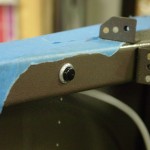

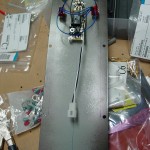
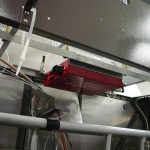
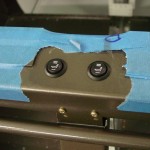

Hours: 3.6 | Posted in Electrical |




































